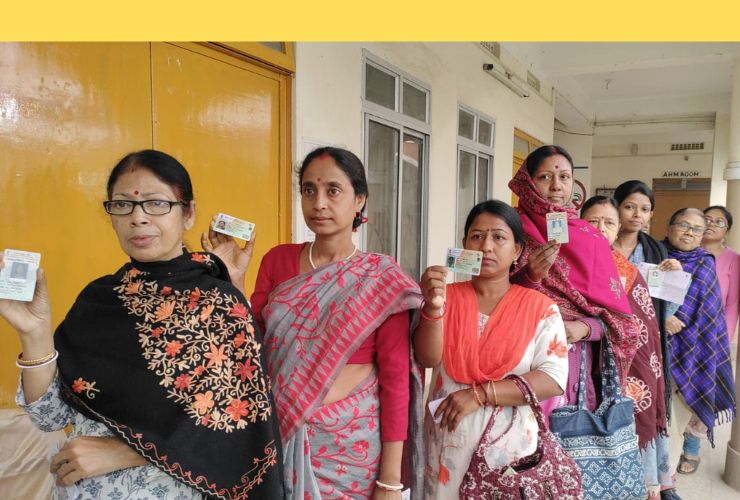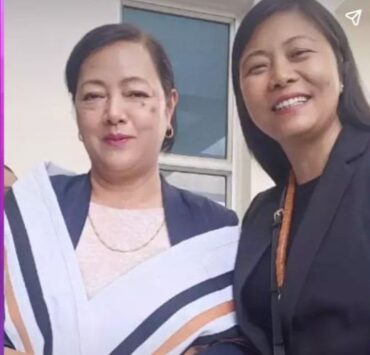
By Durba Ghosh

The recently concluded Tripura Legislative Assembly elections have brought forth a skewed gender narrative. On the one hand, enthusiastic and politically conscious women voters have outnumbered their male counterparts in exercising their franchise while, on the other, only 21 female candidates were given tickets to contest the elections by the political parties in the fray.
The battle for the 60-member house took place on 16 February 2023. Among the 259 candidates standing for election there were only 21 women, constituting less than 10 per cent of the total number. The ruling Bharatiya Janata Party (BJP) fielded the highest number of women – 12 candidates – followed by the regional political party, Tipra Motha, which had five female candidates; the Communist Party of India [Marxist] (CPI[M]) fielded two women while the Indian National Congress (INC) fielded just one, as did the Indigenous People Front of Tripura (IPFT), a regional party and an ally of the BJP. No independents contested the elections this time.
The outgoing Assembly had six women members (MLAs), including five from the BJP and one from CPI(M). Only one of them, 32-year-old Santana Chakma, got a ministerial berth, given charge of the Ministry of Social Welfare and Social Education and Animal Resource Development.
However, women’s representation in the three-tier Panchayat and urban civic bodies is on an upswing in Tripura, with an over 40 per cent presence in these institutions of local governance. Most of these elected women representatives at the grassroots level are popular for their effective performance of their duties. Woman activist Nandita Dutta pointed out in an interview that women’s representation in Panchayat and civic bodies in the state is very encouraging, with several such institutions even headed by women.
At the same time, Dutta lamented the ‘attitude’ of girls and women towards politics. “It appears that educated girls and women are not interested in taking up politics as a full time profession as it involves a lot of volatility. The girls always try to get a secure job – be it in the government or private sector. They do not seem to want to be an MLA or MP,” she said. Veteran journalist and poll strategist Sekhar Datta suggested in an interview that there is a traditional reason for the paucity of women in state politics: girls and women in Tripura prefer to live a peaceful life and have no interest in politics. “Those who can deliver in politics don’t want to join a ‘risky profession’ and would rather pick other avenues for their livelihood. This is the primary reason why women are relatively missing in the Assembly,” he said.
Research, historical precedent across India and the testimonies of women politicians indicate, however, that the paucity of female MPs and MLAs is rarely due to lack of interest on the part of girls and women and is more likely due to structural factors and the obstacles set up by political parties. [Also read: Why Nagaland’s electoral history has never had a woman MLA.]
The state has a total electorate of 28,14,584, with a slightly higher number of male voters (14,15233) than female voters (13,99,289). Yet the recent elections saw Tripura’s women voters outnumbering men by three per cent, registering a stunning 90 per cent female voter turnout.
Political parties had gone all out to woo women voters during this election season. The ruling BJP dedicated a considerable part of its election manifesto to women, promising several initiatives and schemes – particularly in the education, health and security sectors – to improve the status of women. The party claimed that they had already provided employment to more than 3.5 lakh women by increasing the number of Self Help Groups from 4,100 in 2018 to 39,370.
The BJP manifesto claimed that girls have already been provided with free education till graduation in government institutions during its regime over the last five years. According to the new manifesto, further financial assistance will be given to meritorious female students pursuing higher education in nationally recognised institutions. The party also promised to launch the ‘Balika Somriddhi Scheme,’ under which a bond of Rs 50,000 will be issued to each family belonging to economically weaker sections of society on the birth of a girl child, and the ‘Mukhyamontri Kanya Atmanirbhar Yojana,’ which will provide free scooties (scooters) to meritorious college-going female students.
In addition, the BJP manifesto promised to provide 33 per cent reservations in all government jobs for women. This new policy was formally announced in 2022 by Home Minister Amit Shah at a public rally in Agartala. The manifesto also promised to increase the remuneration for Accredited Social Health Activists (ASHA) as well as Anganwadi workers and helpers and to provide them with a one-time gratuity of Rs 50,000 at the time of their retirement. In addition, the party promised to double the number of women in the police force and establish a Veerangana Battalion as the state’s first all-women police battalion. It also claimed that the ruling party had already established Women’s Help Desks in more than 70 police stations and that the facility will be expanded to all police stations in the state.
In terms of healthcare benefits, the BJP promised to achieve 100 per cent in-hospital deliveries by providing an additional cash incentive of Rs 4,000 under the Mukhyamantri Matrupushti Uphar Yojana, ensuring maternity wards at all levels of the healthcare system, and establishing a dedicated task force to further reduce the maternal and infant mortality rates to below the national average.
The Tipra Motha, the latest entrant in the state’s electoral politics, created quite a flutter while campaigning for the Assembly polls by highlighting the demands of the indigenous community and is expected to upset a few veterans in some seats. Motha has promised 24-hour healthcare services, the formation of all-women task forces for safety and security at the village level and all-out action against poverty, hunger, violence and drugs to improve the lives of women who are most affected by these issues.
Tipra Motha’s manifesto generated much interest among political and gender activists as it was the only party that talked about ensuring ”equal respect and opportunities” for the LGBQTI community in the state. Motha leader Pradyot Bikram Manikya Debbarma claimed that if the party forms the government, they will work towards safeguarding the rights of the LGBTQI community, pointing out that by including them in the manifesto, ”we have reaffirmed our outreach to all people irrespective of religion, ethnicity, caste, class, economic status and orientation of any kind”.
In separate party manifestos, the opposition alliance comprising the Congress and the Left Front has promised strict action on crimes against women, provision of free treatment in public hospitals, special marriage assistance amounting to Rs 50,000 for daughters of families below the poverty level and free education for female students from kindergarten (KG) to the post-graduate (PG) level, among other incentives.
On the question of women’s representation in the Assembly, the BJP’s Kalyani Roy, the party’s Chief Whip in the outgoing Assembly and a lawyer by profession, lauded Prime Minister Narendra Modi for giving women the chance to discharge their duties at par with their male counterparts. “In Tripura, the BJP has given tickets to 12 women candidates for contesting the elections, which is satisfactory, ” she said.
However, Roy has also bluntly acknowledged that women are not given the scope to become MLAs or Members of Parliament (MPs) despite their ability to perform duties at par with, if not better than, male counterparts. “Recently, I went to Arunachal Pradesh, where there is no woman in the cabinet,” she said in an interview. “In Tripura, a 12-member cabinet has only one female MLA. Why should it not be 33 per cent? The Chief Ministers of the states should give more chances to women in policy and law making positions.”




